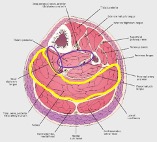Shin Splints, also called medial tibial stress syndrome (MTSS), describes an often sharp pain along the inner part or the back of the tibia (shin bone). The pain generally gets worse when walking, running, playing sports or even just standing for a while.
Good news is that the latest research has confirmed the effectiveness of using physiotherapy to address this issue and improve your situation. Here are a few facts you need to know to live a pain free life and perform better in your sports with shin splints.
a. What causes shin splints and what can be done for it?
Shin Splints is basically due to the tightness and overload of the muscles around your tibia, for instance your calf muscles. These tight and overused muscles further cause some inflammation of your shin bone and as a result you feel pain. To address the issue, recent studies show that appropriate strengthening programs to your foot and leg muscles along with foot orthotics (customised inner-soles) is the best treatment.
Three muscles that contribute to Shin Splints are Tibial Posterior, Flexor Digitorum Longus and Soleus as highlighted in the picture. These muscles are attach to inner (medial) side of the tibia where pain is usually present. When stressed or overloaded, they produce inflammation at their insertion on the lining of the bone (the periosteum).

b. How do physiotherapy help me out from the pain?
Physiotherapists in Form and Practice are well-educated and have been practising as sports or musculoskeletal physiotherapists for many years. We have a wide range of treatment plans for you to help you out from your pain and speed up your time returning to sports and work. Physiotherapists in Form and Practice use dry needling, massage and taping to reduce your pain and prescribe the most suitable programs for you. These methods have proved to be the frontline treatment for Shin Splints by research.

In addition, we use a GaitScan system to analyse foot pressure while walking and running, which allows us to prescribe an individually customised orthotic for you. Again, the latest research shows orthotics to support your midfoot as well as absorb the shock force while walking is one of the most effective treatments for shin splints.
c. How long does it take to heal and where shall I start?
Unlike other conditions, reducing the pain below 2/10 while walking, standing and running is the priority, even before prescribing any exercise to load the bone and muscles. This process usually varies but we know some patients can achieve it within 2-4 weeks. As professional physiotherapists we aim to help you return to sport and work within this timeframe.
Severe cases can take many months and in some cases can lead to worse conditions such as stress fractures and compartment syndrome, so if you are suffering from shin splints do not delay in seeking treatment.
Book an initial assessment with any physiotherapist in Form and Practice and we will offer you the most appropriate and evidence-based treatment plan to address your shin splints!
